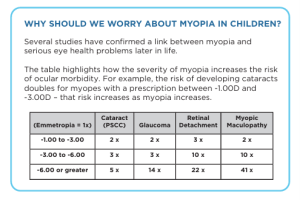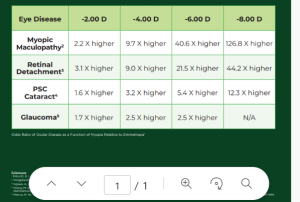
At Clear Vision Ophthalmology, we’re committed to preventing disease in the next generation
Our wholistic approach to myopia control is driven by evidenced based medicine and considers each child’s clinical findings, lifestyle, and family preferences to provide optical outcomes for your child. We focus on slowing down the progression of myopia. During the initial consultation, our doctors will review all the treatment options and create a customized plan for your child. We understand a parent’s schedule can be extremely busy, so we also offer consultations via Telehealth for your convenience.
FAQs
What is myopia and what causes it?
Myopia (nearsightedness) occurs when the eye grows too long to be able to focus light to the back of the eye (retina). A study from the IMI (International Myopia Institute) showed that 30% of the population was myopic in 2020 but it is projected to increase to 50% by the year 2050. There are many risk factors to having myopia develop and the known studied links are listed below.
- Family history of myopia
- Children who have parents with myopia are more likely to become nearsighted. If one parent is myopic, there is an increased risk. If both parents are nearsighted, there is a 50% chance the child will become myopic.
- Kids with less than two hours of outdoor activity daily
- Time outdoors has been studied to prevent the development of myopia. Children who do not get this time outdoors with exposure to the sun are at higher risk.
- Extensive near work
- Family history of connective tissue disorders/hypermobility
- Children born prematurely
- Ethnicity:
- Highest risk are East Asians, Asian Pacific Islanders and South Asians.
- Lower risk: Hispanic and black have lower prevalence compared to the high-risk group but still have notable rates of myopia.
Why is myopia control important for children?
Managing myopia (nearsightedness) early is important because the more severe it becomes, the more it can harm a child’s eyes over time. Taking steps now can help prevent serious vision problems and protect their eyesight in the future.
Examples of these diseases are retinal detachment, glaucoma, and myopic maculopathy—all of which can lead to blindness. Early intervention can reduce these long-term risks. Having a lower level of myopia will positively impact quality of life and education.


- Increased Quality of Life and ease of education. Lower degrees of myopia lead to better vision when corrected and uncorrected. Poor vision or uncorrected vision can negatively impact scholastic performance and physiological well-being. Myopic eyes are also more susceptible to severe ocular injury in the event of trauma due to a thinner sclera.
- Better surgical outcomes. High myopia carries an increased risk associated with intraocular surgeries. The sclera is often significantly thinner in myopic eyes, making surgical procedures more complex.
- Economic impact and global burden
- Global cost of uncorrected refractive error was $202 million annually
At what age should my child be evaluated?
Parents who are near sighted should consider having a comprehensive eye exam for their child as early as one year old. A complete eye exam of the eyes and binocular system is recommended before schooling starts in pre-K.
Will my child’s vision continue to get worse every year?
Once a child develops myopia, there is an expected average rate of progression. A diopter is the unit used to measure glasses and contact lens prescriptions. Myopia generally accelerates worse through adolescence.
We are pleased to share that there are evidence-based treatments that can be used to slow the worsening of myopia.
What are the main treatment options for myopia control?
- Atropine eye drops
- The drops are applied at night before bed and your child wears their usual glasses or contact lenses during the day.
- MiSight Soft contact lenses
- New and only FDA approved lenses that are worn during the daytime. They are convenient daily soft contacts that are worn during the day and disposed of at night, eliminating the need of storing solution.
- Every child’s needs are different. The best option depends on your child’s age, degree of myopia, eye health, lifestyle, and preferences. When you book an appointment with us here, we will evaluate these factors to recommend an appropriate personalized treatment plan.
At what age can you start treating myopia?
Studies have been conducted for children ages 4–12. Our youngest patient started treatment at four years old! Many factors are considered in the initiation of treatment.
Is my child too young for contacts?
MiSight is specifically designed for children. The studies included kids aged 8–12 years old, but even five-year-olds have successfully learned how to wear contact lenses.
How long does my child need to continue myopia control treatment?
Myopia control is generally a long-term strategy, often continuing until the child’s eyes stop growing (usually into early adulthood). Regular eye exams help determine when, or if, treatment can be stopped.
Are there any strategies for preventing myopia?
While there are many biological factors that cannot be altered, there are habitual changes that help both maintain healthy eyes and reduce visual strain.
- Spending two hours outside daily PRIOR to needing nearsighted correction has been shown to be protective.
- Low Dose Atropine drops have been shown to delay onset of nearsightedness for those at high risk.
- Having an appropriate reading distance for near work.
Don’t hesitate to ask about these steps during your eye exam with us!
Studies and Resources
Atropine for the Treatment of Childhood Myopia
A 3-year Randomized Clinical Trial of MiSight Lenses for Myopia Control
Low-Concentration Atropine for Myopia Progression (LAMP) Study
Atropine at CVeye: What Makes Us Different?
While many practices may prescribe atropine drops for myopia control, our approach at CVeye is different. We don’t just prescribe a treatment—we provide comprehensive care that emphasizes measurement, monitoring, and safety.
1. Measurement and Monitoring
- Use advanced diagnostics to measure eye growth and assess progression.
- Carefully monitor whether treatment is effectively slowing myopia.
- Adjust the treatment plan as needed for each child.
Without this level of monitoring, a child could be treated unnecessarily—or ineffectively. It’s like prescribing blood pressure medication without ever checking blood pressure: incomplete and potentially unsafe.
2. Compounding Consistency
Atropine for myopia control requires very low concentrations that are not widely available. We partner with a trusted compounding pharmacy that specializes in preparing these exact concentrations. This reduces the risk of variability and ensures your child receives a safe, consistent, and effective treatment.
The Value of Comprehensive Care
Patients at CVeye are not paying just for a prescription—they’re investing in a structured program of diagnostics, protocols, and ongoing monitoring that ensures treatment is both necessary and effective. This is what sets us apart.
Addressing Common Questions
“Why not just get atropine drops from another doctor?”
- Other practices may provide atropine without follow-up or monitoring. This is ultimately a disservice to patients.
- At CVeye, we track whether the medication is actually working and tailor treatment for each child.
- We ensure medication quality by working only with trusted pharmacies.
This difference is why many families choose to transition their child’s care to CVeye, even if they’ve received atropine elsewhere.
MiSight at CVeye: What Sets Us Apart
While many practices may dispense MiSight for myopia control, our approach at CVeye is different. We don’t just prescribe a treatment—we provide comprehensive care that emphasizes measurement, monitoring, and safety.
1. Measurement and Monitoring
- Use advanced diagnostics to track eye growth and myopia progression.
- Monitor whether MiSight lenses are effectively slowing progression.
- Adjust the treatment plan based on each child’s results.
Without this level of monitoring, online vendors may sell the lenses but miss whether they’re actually working. It’s like getting braces without orthodontic checkups — ineffective and potentially harmful.
2. Fit and Safety
- Evaluate corneal health and ensure the lenses fit each child’s unique eyes.
- Educate families on safe handling and hygiene.
- Check for complications like inflammation, poor fit, or discomfort.
Online vendors often skip this step, which can compromise both safety and results.
3. Program Structure vs. Just a Product
Families at CVeye aren’t just buying contact lenses — they’re investing in a structured care program that includes:
- Regular visits to track efficacy and safety.
- Access to doctors who specialize in myopia control.
- Adjustments if the lenses aren’t achieving the desired outcome.
Ordering MiSight lenses online may seem convenient, but it’s incomplete care. Without proper monitoring, a child could continue progressing — and lose the opportunity to slow their myopia effectively.
Addressing Common Questions
“Why not just order MiSight lenses online?”
- Some online providers may prescribe MiSight but have no structured way to follow up.
- Without follow-up, there’s no way to know if the treatment is working or if the lenses are safe.
- CVeye ensures both outcomes and safety — that’s the difference.
MiSight® contact lenses are FDA-approved for myopia management and are only legally available through authorized health care providers. Purchasing from unauthorized or online sources not only violates CooperVision’s terms but also risks receiving counterfeit or compromised lenses that could ultimately harm your child’s eyes.
At our office, the cost reflects both the lenses and the comprehensive care and monitoring that ensures MiSight is working safely and effectively. Your child’s progress, eye health, and vision are continuously evaluated and adjusted as needed to ensure long-term success.
While we understand cost is a concern, our pricing reflects a complete treatment program tailored to your child — not just a product. We also offer payment options to make this care more accessible. At the end of the day, your child’s health and future vision are the top priority.
